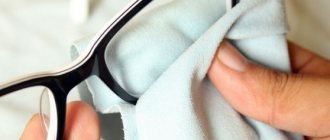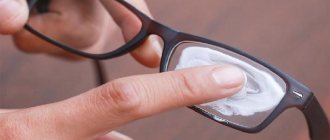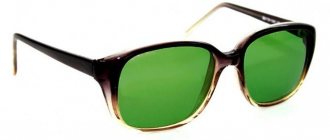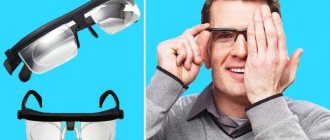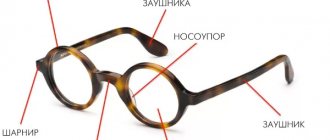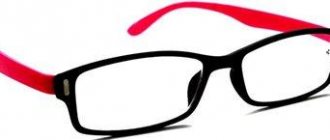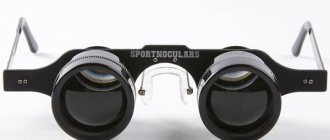Many people wear sunglasses every day, using them as an accessory that complements their look and is part of their style. These glasses have another important function - protecting the eyes from ultraviolet radiation on sunny days. Let's look at how to choose the right sunglasses that do the best job.
In this article
- Types of ultraviolet rays
- Why do your eyes need UV protection?
- What type of protection is acceptable for sunglasses?
- What other markings of sunglasses exist?
- Choosing sunglasses by darkness level
- What shade levels are there for glasses?
- Do glasses have any other protective properties?
Most people don't know how to choose good sunglasses that not only fit their face shape and are durable, but also protect their eyes well from ultraviolet radiation. The choice of optics must be thorough: counterfeit glasses not only do not protect the eyes, they can cause a decrease in visual acuity.
The choice of sunglasses is quite wide; there are many brands - both popular and those that do not yet have a rich history. The variety of shapes and colors is amazing and sometimes distracts from the main thing: the protective properties of the lenses. How to choose sunglasses by type of protection? We'll tell you later in this article.
Types of ultraviolet rays
To make sure that you need to protect your eyes from direct sunlight, you need to study their types, methods of occurrence and the result of their impact on the human optical system.
Approximately 40% of the rays are visible, they are necessary for the ability to distinguish colors. 50% of the sun's rays are infrared, thanks to which a person feels warm. The remaining 10% of the rays are ultraviolet, this is radiation that the human eye does not perceive. Waves come in different lengths, depending on which long-, medium- and short-wave radiation is distinguished.
- Long-wave ultraviolet radiation (UVA) reaches the earth's surface.
- Medium wave (UVB) - delayed by the atmosphere, but can penetrate to the earth's surface.
- Shortwave (UVC) - does not reach the Earth, it is prevented by the ozone layer.
Advantages and disadvantages
To decide whether it is worth purchasing polarized glasses or doing without this feature, you need to weigh all the pros and cons of the purchase. After all, a good model will cost a lot of money, and a cheap one will not give the desired effect.
Advantages:
- no glare or glare;
- the eyes do not get tired from prolonged strain;
- create protection from direct sunlight;
- indispensable in certain types of activities;
- Help people with photosensitivity.
Flaws:
- when the sun is at its zenith, glasses cannot protect;
- high price;
- if you have vision problems, glasses will not correct them;
- dim the light from signs on the road, side lights and brake lights;
- may distort the distance;
- are inconvenient if you use a navigator or other devices with an LCD display, as they darken the image on it.
Using glasses with polarization is undoubtedly convenient, and if you take into account the small disadvantages, you can avoid the problems that they cause.
Why do your eyes need UV protection?
Many experts believe that a moderate amount of ultraviolet radiation not only does not harm, but also benefits the body: radiation strengthens the immune system, tones the body, and improves mood. Ultraviolet radiation helps stimulate metabolism in the visual system, improves blood circulation and has a beneficial effect on the functioning of the eye muscles.
If we talk about the general effect of ultraviolet radiation on the body, it promotes the production of vitamin D and histamine, as well as strengthening the musculoskeletal system.
However, excessive exposure to ultraviolet rays causes great harm to the body in general and the visual organs in particular.
The lens of the eye absorbs long-wave ultraviolet radiation, causing it to become less transparent and acquire a yellowish tint. Clouding of the lens leads to cataracts, which often cause blindness. The mucous membrane of the eye and the cornea perceive medium-length waves, as a result of which their structure deteriorates and they cannot perform their functions. This is why the eyes need a good degree of radiation protection, which can be provided by properly selected sun-protection optical products.
To choose high-quality and effective sunglasses, you need to know what level of protection they have from ultraviolet rays. This is a fundamental factor that should be paid attention to when choosing an accessory.
Steps
Buying original glasses
- Pay attention to the label and logo.
On branded glasses, logos are usually placed on the lenses, temples or the inside of them, and the size, color and model are also indicated on them. Any seemingly insignificant error may indicate that your glasses are fake. Typos in brand names (for example, “Guci” instead of “Gucci”) indicate that the glasses are fake. Before purchasing, visit the manufacturer's website and check the labeling and logo. This will help you when making a transaction directly.
Pay attention to the model markings.
The model number is the same worldwide, regardless of whether you bought your glasses online or in a store. Go to the manufacturer's website to compare the sunglasses model number. As a rule, the model marking can be found on the frame. Counterfeit glasses may have numbers that are not listed on the manufacturer's website.
Buy glasses only from a trusted seller.
Genuine glasses are usually sold at official representative offices of the company. On the street, most likely, they will sell you a fake. You are dealing with a fake if the price is too low and suspicious. Stay away from sites that do not allow returns and where you cannot find contact details (such as phone number, email address, etc.).
- China is the birthplace of most counterfeit items. Be careful when purchasing products made in China.
- When purchasing goods online, you need to check the traffic to this site and customer reviews.
- Websites selling original products must have a certificate of authenticity.
- The glasses you buy must be made with high quality and have an impeccable appearance.
- Recognize keywords.
Words such as “high quality”, “cosmetic”, “replica”, “sample” often indicate that the glasses are counterfeit. Notice if the seller uses one of these phrases. In addition, such glasses can easily break and do not protect your eyes from ultraviolet rays.
Listen to your intuition.
There are many signs of authenticity of glasses. Use common sense and intuition. Find out more information about the company you are purchasing glasses from. There are really favorable conditions for purchasing original glasses. If the price is really low, study all the characteristics before making a purchase.
Check your glasses
- Check the packaging.
Genuine brand glasses are sold in original packaging. A label with a barcode and information about the manufacturer must be placed at the bottom of the box. Quality certificates and a warranty card must also be included.
Inspect the packaging carefully.
Glasses must be supplied in a branded case. The brand logo must be located on the case. The cover must be in perfect condition, without scuffs. The color and shape of the cover may vary depending on the year of release of the collection.
Check lenses and nose pads.
In authentic glasses, the logo is often located on the right lens. It must be clear and understandable. Nose pads should be located on the frame in the nose area. Some glasses also have the logo printed on the nose pads.
Check the glasses for compliance with all parameters.
The logo, serial number and model type must be printed on the glasses. The numbers on the label and box must match the number of the glasses. The logos on the glasses, case and label must be identical. Your glasses may very well be fake if you notice any inconsistencies or typos.
Pay attention to quality.
Glasses and their packaging must be of high quality. Glasses that are flimsy or too light may be fake. New original glasses are usually sold in beautiful packaging with tags and a case. The fake is sold in a low quality box or soft packaging.
- It is especially important to check the quality of the product if you are buying used glasses, as they are often sold without the original packaging.
What type of protection is acceptable for sunglasses?
Not many people know that dark lenses do not mean good protection from ultraviolet rays. The degree of protection of sunglasses does not depend on the color of the lenses: it can be high even for optics with clear lenses: the main thing is that a special protective coating is applied to their surface. In some cases, dark lenses can be even more harmful: in the dark, the pupil dilates, which is why harmful rays are fully absorbed by the lens. So how do you choose the level of protection?
Popular brands have markings on glasses that indicate the level of radiation protection. The best option is accessories marked “UV400”, which do not transmit 99% of long-wave ultraviolet radiation. It is worth noting that such glasses not only protect the eyes from the sun: they do not allow the sun to reach the skin, so if worn constantly in the summer, white circles may form on the face on the protected areas of the skin.
The most popular sunglasses are labeled “UV380” - they block up to 95% of harmful rays. Very cheap, off-brand products block approximately 50% of ultraviolet rays, which is equivalent to almost no eye protection from radiation.
They can be used solely to add zest to the image, without relying on serious protection.
Some sunglasses are labeled as protecting against mid- and long-wave ultraviolet rays: “Blocks at least 80% UVB and 55% UVA.” The percentage may vary, but products are effective if the level of protection against each type of ultraviolet rays exceeds 50%.
Do glasses for 8,000 and 300 rubles protect the same from the sun?
There is hardly a shopaholic in the world who has not bought something more expensive, hoping that this is a guarantee of quality.
- Well, what good things can you buy for 300 rubles? - my glamorous friend laughed when I showed her off my new acquisition from the clothing market - sunglasses.
- They look no different from expensive ones! — I tried to reason with this victim of advertising. - Yes, and the quality is probably the same.
SCIENTIFIC EXPERIMENT
To resolve our dispute, we had to conduct a real scientific experiment.
So, we collect 15 pieces of dark glasses according to the editors.
1) Two expensive pairs: Adidas (RUB 8,000) and Ray Ban (RUB 5,000).
2) Seven pairs of glasses for the average wallet: Polaroid (2000 rubles), Gepard (1300 and 1500 rubles), Mango (1500 rubles), Fresh (1200 rubles), Morgan (1100 rubles), Aviator (1000 rubles) .
3) And the six cheapest: Aolise (500 rubles), Eternal (400 rubles) and four pairs without identification marks, only their prices are known: three pairs for 300 rubles and one for 150.
We took all this wealth to the specialists at the optics salon, to check it on a special device - a tester. It is also called a spectrophotometer. This is a special device that can measure the wavelength of light. Remember physics? Light is waves and they have a length. Ultraviolet is an invisible short wavelength (less than 400 nanometers). In short (and more dangerous) only x-rays and radiation. The device is designed in such a way that it catches ultraviolet rays with a sensitive eye - an indicator. You bring your glasses to it, on which at this time a special lamp shines with ultraviolet light, and if the rays do not penetrate the eye, then the green light comes on. This means the glasses protect 100 percent. If a yellow light comes on, or worse, a red light, there are impostors in front of you.
The result, to be honest, surprised us very much: 14 out of 15 copies passed the test - both for 300 rubles and for 8000. Only one pair was disgraced - these glasses were bought for 150 rubles.
THE PRICE IS INCREASED TEN TIMES
“All glasses protect against ultraviolet radiation equally, but in other respects the cheap ones fail,” says Danil Valiev, who has been assembling and selling glasses for several years. — With cheap glasses, the frames quickly become loose, the temples are crooked, and they often do not fit well on the bridge of the nose. I also had cases when in Chinese shipments I came across glasses with diopters: the eyes in such glasses will get tired. In China, I often bought for 30 - 70 rubles, and sold for 250 - 400 rubles.
“We often pay not for the thing, but for prestige,” says marketer Marat Akhunov. — All brands do image boosting. Usually it is 30 - 50%. For exclusive, designer goods, the price can be increased by 90%. That is, if you buy an advertised product, feel free to subtract this markup from it - and you will see the real cost.
EXPERT'S COMMENT
Zarema KUDASHEVA, ophthalmologist, head of the department of optics, Ufa Research Institute of Eye Diseases:
- Long-term exposure to ultraviolet radiation can lead to burns of the retina or cornea, and even to the development of cataracts. Even through closed eyelids, radiation also penetrates, albeit minimally. Therefore, on the beach, do not forget about eye protection. Damage from radiation has the ability to accumulate in our eyes, and at some point it can shoot out. It’s better, of course, to buy glasses in optical stores, where you can check them on a tester, but in the market you are unlikely to be provided with such a service.
IMPORTANT!
If you notice that the skin under your glasses does not tan, then the glasses do not transmit ultraviolet radiation. If it stubbornly turns brown, it’s time to worry, perhaps you were sold a fake.
BY THE WAY
Plastic or glass?
For the manufacture of lenses, in addition to glass (which does not transmit ultraviolet radiation by default), plastic is used. This material itself does not protect against ultraviolet radiation. Previously, for this purpose, a protective coating was applied to the lenses, but now they are moving away from this technology, because the protective layer wears off over time.
Today, plastic contains additives that do not allow harmful rays to pass through - these are ultraviolet absorbers, read - absorbers. The price depends on them.
We read the inscriptions on the label:
100% UV protection or UV 400 (meaning nanometers - this is the wavelength of ultraviolet light from which the glasses protect) - the inscription means that the manufacturer guarantees that the eyes will be safe.
The degree of darkness of glasses is the parameter that shows us how much light the lens allows through. There are five categories of light transmittance.
Category 0 - these are glasses that transmit 100 - 80 percent of light, that is, the minimum degree of protection from light (not to be confused with protection from ultraviolet radiation, all glasses should protect from it!), Mainly used for fashion glasses, in which you can go to for example, to a club.
Category 1 - glasses in this category transmit 80 - 40% of light, they are slightly darkened, such glasses can be worn on cloudy days in the city.
Category 2 - 40 - 20% light. Moderately tinted glasses. You can wear them in cloudless weather in the city.
Category 3 - glasses that transmit 20 - 8% of light. These glasses can already be worn on the beach, on the seaside, they will protect you from the bright sun. They are quite dark. In addition to southern resorts, they can also be worn in the mountains.
Category 4 - transmits less than 8% of light. They provide maximum protection from the sun, but you should never drive a car in them. This type of protection is mainly used in ski goggles.
What other markings of sunglasses exist?
- Cosmetic - these sunglasses block less than half of the total amount of ultraviolet radiation. They should not be worn on very sunny days, as the eyes will be vulnerable in them.
- General - optical products of a universal type. They block up to 80% of ultraviolet rays. These accessories can be used for daily wear in cities located at mid-latitudes.
- High UV-protection - the most reliable glasses models, protecting the eyes from radiation by 99%. They can be used not only in urban environments, but also when walking in the mountains, near the water and in other places with maximum exposure to sunlight.
Where to buy and how much do these glasses cost?
If you decide to purchase polarized glasses, then head to a specialized store. You won’t find a good quality product on the same shelf as regular sunscreen models. At an optical store, you will not only get useful glasses, but you will also be able to test them on the spot. The seller will give you a guarantee and, in case of defects, will exchange the goods.
The price of polarized glasses can range from several hundred to thousands of rubles. The cost depends on the technology used to make the lenses. If the filter is placed on the outside of the glasses, they will be cheaper and less durable.
It is better to purchase models where the filter is built into the lens, that is, located in the middle. To accomplish this task, two very thin lenses are made, a polarizing filter grid is placed between them, and then they are glued together. This ensures durability and long service life of the glasses.
Check the goods without leaving the checkout. In the store itself you can find out how high quality the glasses you are going to buy are.
How to check in store:
- In good retail outlets, sellers have special indicator strips that will help you determine the quality of the polarizing filter. Look at the indicator through your glasses and you will see an image that you cannot see without them.
- Take the second polarized glasses, place them opposite each other, and then rotate one 90 degrees so that the centers of the lenses coincide. If they darken in places where they coincide, then the glasses are of high quality; if the visibility has not changed, then no.
What should those who have had polarized glasses for a long time do and cannot check them in the store? There are several tricks for this case.
How to check at home:
- Turn on your monitor, TV or smartphone, as long as it has an LCD display. Point the glasses at it and turn it 90 degrees again. If the filter is of high quality, then the image through the lenses should no longer be visible.
- If you have an aquarium at home, look at the bottom through your glasses. A good filter will allow you to see what is there even through muddy water.
These methods are enough to understand what kind of glasses you have, regular or polarized.
Choosing sunglasses by darkness level
Once the required degree of protection from ultraviolet rays has been determined, you need to select the level of light transmission of the lenses or their tint. This parameter affects the quality of perception of surrounding objects. Finding out the relevant information is easy: it is located on the temple of the sunglasses. The marking contains the model name and a number indicating the darkness level.
Recommendations for choosing good glasses
Pay attention to the temples . This is where manufacturers most often indicate the presence and level of ultraviolet protection. It may look like this: CE or UV400.
Do not buy glasses at markets and street stalls . Firstly, there are no instruments with which you can verify the properties of the product. Secondly, in this way they usually sell counterfeit and low-quality products that have not passed the necessary tests.
Don't try to save money . Reliable sunglasses cannot cost less than 1 thousand rubles. Exception: sales.
What shade levels are there for glasses?
As mentioned above, on the temples of sunglasses, in addition to the name of the manufacturer, there is a number. Here's what it means:
- 0 - glasses with almost completely transparent lenses that transmit over 80% of the sun's rays. As a rule, such sunglasses are used by athletes who train outside in the absence of bright light.
- 1 and 2 - optics that transmit 40-80% and 20-40% of sunlight, respectively. These are the most acceptable options for everyday wear in urban conditions with average solar radiation.
- 3 and 4 are the darkest glasses, which will be comfortable in bright light.
The best option would be to wear sunglasses with light transmission levels 2 and 3 every day. In spring and autumn, the most effective eye protection will be accessories with 1 or 2 degrees of darkening. Glasses with markings with the number 4 written on them are suitable for those who engage in extreme sports or simply spend a lot of time outdoors, for example in the mountains or at sea.
As mentioned above, the darkness of the lenses does not in any way affect the level of eye protection from ultraviolet radiation: only the quality of the eye’s perception of surrounding objects and the comfort of wearing these accessories on sunny days depend on the color of the glasses.
What to do to make your glasses last a long time
If you want your purchase to please you for many years and help protect your eyes, then follow the rules for storing glasses with polarized lenses:
- Buy a quality case that is durable on the outside and covered inside with genuine leather or fabric.
- To clean the lenses, use a soft cloth; it usually comes with your glasses. Do not rub them on clothing or rough fabric.
- If the glass becomes very dirty, wash it with soap and water; it is not recommended to use other detergents.
- Do not place glasses with the lenses facing down, as this will cause scratches. To prevent your glasses from accidentally falling, secure them with a chain.
The quality and durability of polarized glasses depends on the manufacturer. Companies that respect their customers always sell goods through chains of pharmacies and opticians, so you should not save money and buy them in dubious stores, but rather go to specialists.
Do glasses have any other protective properties?
Most modern brands care not only about beauty, but also about the convenience of their products. Manufacturers are striving to make glasses more durable and practical by using the best materials to create them and giving the products more and more functions by applying additional coatings to the lenses.
Such coatings include:
- Polarizing filter. Polarized glasses can block rays that are reflected from surfaces and adversely affect the eyes, impairing the quality of vision for a few moments. This is especially unpleasant for those for whom even a second loss of vision is fraught with big problems - drivers and athletes.
- Another feature is glare blocking. Lenses with anti-reflective coating cut off the glare of the sun, as a result of which the comfort of wearing such glasses increases.
- Mirror coating - all glasses have it to a certain extent. With its help, visible sunlight is reflected, making it more comfortable to be in the sun.
- Abrasion-resistant coating - it protects the lenses from damage due to careless handling (scratches, cracks, chips).
- Melanin coating - it is present on the inside of the glasses and helps prevent eye fatigue when wearing sunglasses for a long time.
- Gradient coating - it increases the safety of driving a car on sunny days, so drivers should choose sunglasses with such a coating. The top part of the gradient lens is darker - it helps improve visibility while keeping your eyes focused on the road. The lower part (light) helps you focus your eyes on the dashboard without any problems.
Thus, if you know how to choose glasses, you can provide good eye protection from ultraviolet radiation and increase eye comfort when exposed to the sun. It is important to pay attention to the available markings and study in detail the information provided by the manufacturer. Cheap Chinese glasses not only do not protect your eyes from radiation, but can also lead to serious vision problems, so wearing them every day is not recommended.
How to check whether glasses allow ultraviolet light to pass through?
It is best to conduct a test at the point of purchase and before making it. To ensure everything goes smoothly, take a UV flashlight with you.
A simple way with a device
Stores specializing in the sale of sunglasses and glasses must have a spectrometer. The buyer has the right to use it and check the product before purchasing, you just need to ask the seller to provide access “to the device” . The check itself takes only a few seconds. It is enough to bring the glass to the reading element, literally immediately after that the numbers will appear on the screen. This will be the required indicator.
Important! Don't forget to check the resulting number with what the manufacturer stated in the description. If the values do not match, there is a high probability that you are holding in your hands not the original, but a copy.
In addition to the spectrometer, a photometer is used to determine UV transmittance. It does not show numbers, but the type of lenses. Explanation of values:
- DANGER – red light – a signal that the lens transmits over 12% of UV rays;
- CAUTION – yellow light – the lens transmits 4–7% of UV rays;
- SAFE – green light indicates high glass protection.
Try to purchase products that were classified as SAFE when testing the photometer.
Checking without technology
It is impossible to determine the presence of protection “by eye”, since human vision does not perceive ultraviolet radiation, it simply does not see it . To confirm this, illuminate the lenses with a UV flashlight. You won't notice anything unusual.
To be able to see the difference between glass with and without ultraviolet protection, you will need a beam source of the appropriate type and an object with luminescent properties. For example, a sticky note, pen or marker. This thing is placed on the table and the light of a flashlight is directed at it. The glasses are placed between the flashlight beam and the luminescent object.
If the manipulation led to the item being illuminated, then this indicates that the glass does not have protection against UV radiation. If the glasses did not let the rays through, then you can safely purchase the pair in question.
Checking with a flashlight and writing
The technique is in many ways similar to the previous one, but you don’t have to look for an object with luminescent properties. It is enough to take a ticket, excise tax or passport and shine it with a flashlight with UV radiation (do not forget to place glasses between them). Invisible holographic signs begin to glow when exposed to ultraviolet light. If there is no glow and no inscriptions or signs appeared during the experiment, then this indicates that a particular pair has UV protection.
Important! Do not try to verify Visa cards using this method. The invisible inscription on them will glow in any case, regardless of the quality of the sun protection accessory.
Testing by practice
The method is suitable for those who have the opportunity to be in the sun for several days in a row and tan quickly enough . If after this time the face changes color, and the skin under the eyes remains approximately the same shade, then we can say that the glasses have protective qualities. True, the severity of the property cannot be determined in this way.
Check with BLB lamp and white cloth
Turn on the light source and place a completely white cloth in front of it. Place glasses between them. If they are of high quality and do not transmit UV rays, then there will be no luminescent effect.
Why is it important to buy real sunglasses?
To be fair, it must be said that not all people become victims of deception by sellers when they buy counterfeit glasses instead of original ones. Many people deliberately choose so-called replicas of famous brands because they are much cheaper and look almost like the original.
However, ophthalmologists warn that using counterfeit glasses can be dangerous for your eyes.
The main task of sun protection optics is to block the entry of ultraviolet rays into the eyes, which have a destructive effect on the human visual organs and can subsequently lead to serious ophthalmological diseases. Reliable protection against ultraviolet radiation is provided by a special UV filter, which must be present in any glasses. Real brand glasses are always equipped with similar filters, which cannot be said about fakes.
Outwardly, they may look identical to the original, but the lack of reliable UV protection makes such lenses dangerous for the eyes.
Nature has provided our visual organs with a natural protection mechanism against UV rays. Eyebrows and eyelashes help minimize harmful radiation entering the eyes, as well as the fact that we squint in the sun, and the pupil constricts in bright light. When wearing glasses, natural protection stops working. Behind dark glasses there is no need to squint, and the pupil is always dilated. If the glasses are fake and do not have a filter that blocks ultraviolet light, much more ultraviolet rays enter our eyes than without any optics. That's why ophthalmologists say it's better not to use sunglasses at all than to wear low-quality fakes.
